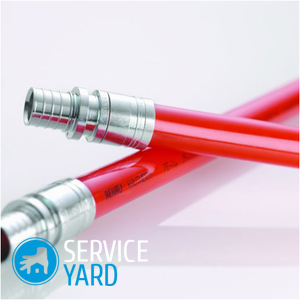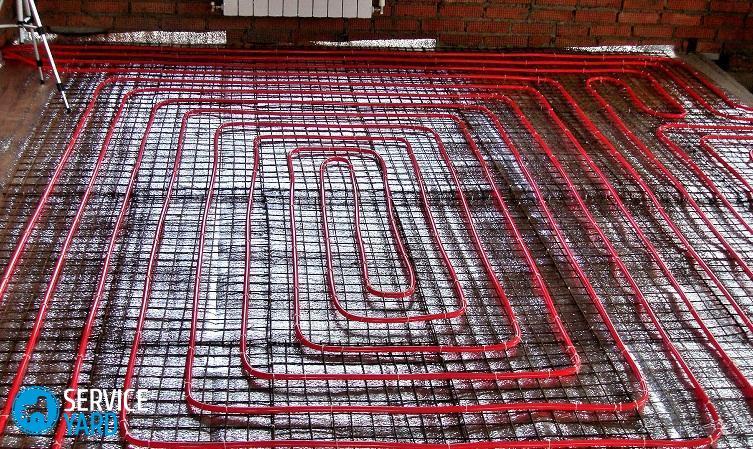Pipe for underfloor heating - which is better?

Heated floors have long been able to prove their effectiveness, which is why today they are used as backup, main, alternative and additional heating systems for residential premises. In regions with mild climates, they can even replace radiators, and in cities with harsh and cold winters they are often used in combination with radiators. Consumers most of all have problems when they need a high-quality and reliable pipe for a warm floor. Which is better and why - you will learn from the article below.
to contents ↑How to choose pipes for installing a warm floor?
In fact, warm water floors are quite complicated in terms of installation, unlike electric ones, but, nevertheless, they are more economical. The key to success is a correctly designed system, the best materials, competent installation.
Important! Installation of a warm floor should be carried out by a person who has a certain experience and qualification, because the result should be perfect. Such a system allows to save 20-30% of resources on heating, because the water in the pipes is heated to 30-50 degrees. It provides high-quality and uniform heating of the room.
The current construction market is quite rich, manufacturers offer a wide range of pipes that are used to install the heating system. But what is the best pipe for a warm floor - we will figure it out further, but for now, check out the equally important points.
When choosing the most suitable option, consider the following factors:
- Durability, durability.
- Thermal conductivity.
- Features of the installation.
- Operational characteristics.
- Value for money.
- Manufacturer Reputation.
Pipes are made from a variety of materials. It can be inexpensive polypropylene and metal-plastic products or expensive copper parts. Their diameter, as a rule, is 16-18 mm. It is recommended to give preference only to pipes designed for heating, in no case for water supply. If we talk about brands, it is better to trust trusted companies with a good reputation. Products must be original and certified.
to contents ↑Important! Of fundamental importance is the durability of the material that was used for the manufacture of pipes. All products must be strong and reliable, since repair itself is an expensive and difficult undertaking.
The most popular pipe materials
Copper, polypropylene or metal-plastic pipe for underfloor heating? Which is better - we will analyze further. Now we will consider each option separately to carefully examine the positive and negative qualities of all materials.
Copper
Copper for many years remains a relevant material, despite the development of modern technologies and the production of new ones.
The main advantages of copper:
- Durability. Bacteria do not multiply on the surfaces of copper pipes.
- Resistance to corrosion.
- The material is able to withstand the lowest and highest temperatures, any mechanical stress.
- Copper pipes do not crack, do not melt, do not burst.
Important! Due to its excellent technical and operational properties, this material is most often used in modern heating systems. If all the conditions are met, then such pipes can last more than 50 years. Naturally, due to this, the initial expenses more than pay off.
But it has copper and some disadvantages:
- The material is sensitive to acidity and water hardness. If the coolant will create an alkaline or acidic environment in the system, then copper pipes will serve two times less than the declared period.
- It is not recommended to combine copper with steel, otherwise - negative electrochemical processes can occur.
- Such structures can only be mounted using press machines, which are quite expensive.
Important! Ready-made water floors from copper pipes are expensive, because in addition to them it is still necessary to buy special connecting elements, fasteners, fittings, which significantly increases the cost of the entire system by about 30%.
In terms of installation, they have no equal, because they are connected by special press fittings, which are incredibly durable. Reliability of the joints often exceeds the strength of the main elements.
Metal plastic
This is a pretty good alternative to copper, and is cheaper, which is why it is in incredible demand.
The advantages of this material include:
- Durability. Plastic pipes can last up to 50 years.
- Environmental Safety. They are completely environmentally friendly, do not react with any other substances and materials that are contained in water.
- Resistance to corrosion.
- Low weight. This is their undeniable advantage over copper products.
- High level of sound insulation. Water does not make noise, moving along drains.
Important! Metal-plastic pipes consist of several layers, they are ideally smooth inside, therefore various deposits do not accumulate in them. The polymer that covers them from the inside protects the structure itself from the negative effects and destruction.
The disadvantages of metal plastic include the following:
- If the adhesive composition is destroyed, the pipes begin to move away from each other - because of this, leaks occur at the joints.
- Plastic does not tolerate exposure to open flame. Fortunately, when installing a warm floor, this does not really matter.
- The likelihood of poor connection. It is necessary to carefully select the diameter of the pipes and fittings.
If you need a metal-plastic pipe for a warm floor, which is better - it is easy to determine. Given that they are able to withstand temperature changes from -10 to +95 degrees, it is necessary to pay attention to this particular nuance.
Important! During installation, they can not be strongly squeezed with union nuts, otherwise - there may be an incision that is guaranteed to leak in the future.
Polypropylene
Not many people risk buying polypropylene pipes for arranging a warm floor, even despite their many undeniable advantages:
- Environmental friendliness.
- Durability.
- Low cost.
Important! In terms of demand, they are not far removed from their copper counterparts, but at the same time they do not scare anyone away with their price. Polypropylene is not very convenient in terms of installation. Such a pipe has a bending radius of 8–9 diameters.
Disadvantages of polypropylene:
- The material does not bend very well, so the installation of such pipes is very complicated.
- Inadequate heat output.
- Temperature limits during installation. The temperature should not fall below 15 degrees, which is absolutely not suitable for cities with harsh climates.
Important! Polypropylene pipes are joined by welding. That is, a welding machine is required for this, but the process itself is relatively simple and does not take much time. The connection is very strong, almost monolithic.
Crosslinked Polyethylene
Polyethylene is a material that consists of hydrocarbon molecules that are completely unconnected.Thanks to new technologies, specialists were able to combine these molecules through the interaction of carbon and hydrogen. As a result, a new material appeared, which was called cross-linked or, more simply, cross-linked polyethylene. It is additionally processed under high pressure, increasing the strength characteristics.
The benefits of cross-linked polyethylene include:
- Excellent functionality in a fairly wide temperature range - from 0 to 95 degrees.
- High temperature of combustion and melting. Material begins to melt only when a temperature threshold of 150 degrees is reached. It burns at a temperature of 400 degrees.
- Molecular memory. Pipes made of this material may deform, but they immediately acquire their original shape and appearance as soon as the temperature is restored.
- Resistance to pressure drops. They perfectly tolerate any changes in heating systems.
- Plastic. Due to this, it does not break, even when the product is severely bent in the same place several times.
- Biological and chemical resistance. Such pipes are insensitive to aggressive chemicals.
- Security. Crosslinked polyethylene is not able to emit harmful substances into the atmosphere. Even when it burns, it decomposes into carbon dioxide and water.
Its disadvantages include the following:
- The material does not tolerate exposure to direct sunlight.
- During installation and transportation, it is necessary to handle the protective layer of pipes with extreme care, otherwise oxygen can enter their structure, which adversely affects their durability.
Later we will bring to your attention the rating of pipes for a water floor heating, but for now, we note that mainly cross-linked polyethylene and metal-plastic products are preferred. Of course, only you can make the final decision, but if you carefully understand everything, you can make an unmistakable choice.
to contents ↑Popular manufacturers of pipes for installing underfloor heating?
The installation of underfloor heating in apartments and houses is becoming increasingly popular, is in incredible demand. The main reason is the saving of financial costs for utility bills. Actually, therefore, the choice of pipes for its arrangement remains relevant. It is difficult for ordinary people to choose the best version of the system from a huge assortment so that it meets all standards of comfort and quality. In this section we will get acquainted with the most demanded manufacturers of such products, compare the quality of their products in order to make a choice.
The rating of water heated floor pipes, depending on the manufacturer, looks like this:
- Sanext is an Italian company that mainly uses cross-linked polyethylene for the manufacture of pipes. Its products are equipped with an anti-oxygen barrier. The noise level in them is significantly reduced due to a three-layer coating of the material. The company provides a ten-year warranty on its systems. The finished system of this company includes all the necessary elements for installing and connecting a warm floor with your own hands.
- Aquatherm is a German company manufacturing pipes from polyethylene using a special extrusion method. The manufacturer guarantees a free system replacement if a breakdown occurs in the first ten years of operation, starting from the time of purchase. Its products can last more than 50 years. The main privilege of the materials of this manufacturer is considered a high rate of elasticity and a small bending radius. All accessories and additionally tools for adjusting the temperature are included in the kit.
- Uponor is a Finnish manufacturer. Millions of facilities around the world are equipped with underfloor heating of his brand. The company uses cross-linked polyethylene and metal plastic. The first - bend perfectly, and facilitate the installation process, the second - withstand significant pressure. The company supplies consumers with the necessary equipment and tools, a kit for self-regulation of the heating temperature.
- Rehau is a German company. It produces three-layer cross-linked polyethylene pipes equipped with an anti-oxygen barrier. Their service life is 50 years. The main difference of this company is the following condition: if the temperature does not exceed 60 degrees, the warranty period will increase to 100 years.
to contents ↑Important! If you compare the variety of diameters of all the above manufacturers, then the best option can be safely called Rehau brand pipes. Taking into account all the mentioned factors, it is worth noting that the first place in quality and characteristics is occupied by Aquatherm, because even with a minimum thickness of the pipes, the maximum temperature and pressure are maintained.
Stock footage
Now you have an idea of how important it is to choose the right pipes for a warm floor. Which product to give preference to - it will be much easier for you to decide, given all the tips from this article.
- How to choose a vacuum cleaner taking into account the characteristics of the house and coatings?
- What to look for when choosing a water delivery
- How to quickly create comfort at home - tips for housewives
- How to choose the perfect TV - useful tips
- What to look for when choosing blinds
- What should be running shoes?
- What useful things can you buy in a hardware store
- Iphone 11 pro max review
- Than iPhone is better than Android smartphones





